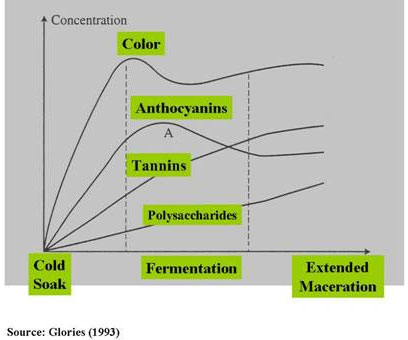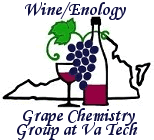Enology Notes
Enology Notes #128, April 25, 2007
To: Regional Wine Producers
From: Bruce Zoecklein, Head, Enology-Grape Chemistry Group, Virginia Tech
Subject: Enological Tannins; Enological Tannins and Red Wine Proteins; Advanced Technical Meeting: Wine Longevity; News from Ken Hurley, the Director of Virginia Tech’s Enology Service Lab: Importance of Reviewing Past Analyses; Grape Genomics Program.
I would like to thank the hundreds of people from around the world who wrote regarding the tragedy that occurred at Virginia Tech. Your thoughtful expressions of condolence and concern and your prayers are greatly appreciated.
1. Enological Tannins. Previous editions of Enology Notes (#70, 95, 97, 98) have outlined and discussed the importance of oxidation-reduction potential (redox). It could be said that tannins are essentially redox buffers.
Enological tannins available on the market may differ in a number of respects, including the following:
- Extraction method
- Purity
- Processing method
- Source, including wood, grape skins, and seeds
- Toasting variation
- Degree of oxidation
Tannins for wine addition can be derived from grape skins, seeds, oak, chestnut, seedpods, etc. Most are water or steam extracted, dried, and milled. Different products undergo hydrolysis, pH and color adjustment, and sulfite addition, and may be finished by spray- or freeze-drying.
There are basically two chemical classes of tannins, hydrolyzable and condensed. These two groups differ in nearly every characteristic, other than their ability to bind with proteins. Hydrolyzable tannins bind with proteins by hydrophobic interactions. Condensed tannins bind proteins through hydrogen bonding. Grape skins and seeds contain only condensed tannins. Hydrolyzable tannins are derived from oak wood or as an additive to wines. Many believe that an addition of condensed and hydrolyzable enological tannins is best, depending upon the purpose.
There is a vast array of tannins on the market, and many are tailored to perform different tasks. Tannins are added for the following purposes and problem corrections:
- Redox buffer
- Raisined fruit
- Sun-damaged fruit
- Unripe grape tannins
- Structural/textural, mouthfeel modification
- Increased substrate for microoxidation
- Limit the activity of laccase
- Help to precipitate proteins
- Help to modify aromas, including vegetative aromas
- Help increase aging potential
- Possibly to help stabilize red wine color
Of the above listed purposes for tannin addition, the most common, perhaps, is for mouthfeel modification. However, important questions remain regarding the benefits of enological tannins due, in part, to the diversity of products and the timing of additions. Winemakers naturally want to be able to accurately predict the impact of tannin additions.
2. Enological Tannins and Red Wine Proteins. Figure 1 illustrates the relative change in spectral color, anthocyanins, total tannins, and polysaccharides that occurs during cold soak, fermentation, and extended or post-fermentation maceration during red winemaking.
Figure 1.

One important red wine processing decision is to determine the use of cold soak or pre-fermentation maceration. The rationale behind cold soak is that aqueous extraction in a non-alcoholic matrix may improve red wine color and color stability. Important cold soak variables include the following (See Enology Notes #6, 41, 76, 80, 81, 103, 107, 109, 117):
- Variety
- Season
- Time
- Temperature
During cold soak, monomeric anthocyanins are extracted which may result in increased red wine color in the aged wine. Tannin extraction during cold soak is limited by solubility, and generally occurs at a slower rate than anthocyanin extraction.
Grape tannins derived from the skin, seeds, and stems differ in their length, overall subunit concentration, and sensory properties, including:
- Astringency
- Stereo-specific nature
- Size
- Number of hydroxyl groups
Seed tannin extraction requires ethanol. Therefore, tannins extracted during the cold soak period come from the skins and stems, not the seeds.
It has long been understood that excessive seed tannins can impart negative sensory qualities to red wines. As such, winemakers are concerned with seed “maturity”, and some even deport seeds during délestage (See Enology Notes #8, 23, 69, 76, 78, 80, 81, 90, 103, 114).
An area of renewed research interest in red winemaking is red wine proteins. Specifically, the following questions are under review:
- What tannins react with and precipitate with red wine proteins during cold soak?
- What is the impact of these reactions, if any, on red wine mouthfeel and color stability?
- Does the use of enological tannins during cold soaking impact which tannins react with protein, and which tannins remain in wine?
Except for low phenol varieties, such as Pinot noir, most winemakers are not too concerned with red wine proteins, but perhaps they should be. A characteristic of tannins is their ability to bind with proteins. Indeed, traditionally we use that reaction, in part, as a generalized definition of tannin. Protein binding results in different tannins binding differently to proteins, or perhaps binding to different proteins.
During cold soaking, there is an increased extraction of both protein and tannin from the fruit solids into the aqueous phase. Proteins and tannins can bind together and precipitate from solution. Is it possible to selectively precipitate some phenols, while leaving behind the sensorially-desirable phenols?
It has been suggested that some enological tannins can preferentially bind to red wine proteins and precipitate (Robbins, R., Laffort Oenologie), allowing skin tannins to remain in solution. Because of the desirability of skin tannins in wine mouthfeel, and the importance of maintaining a desirable anthocyanin to tannin ratio (see Enology Notes #116, 118), addition of enological tannin during cold soak may be valuable.
3. Advanced Technical Meeting: Wine Longevity. A meeting to discuss the issues of wine longevity will be held at Horton Cellars, Monday, May 21 from 1:00 PM to 4:30 PM.
This program is for Virginia commercial wine producers only. Pre-registration is required. The program fee is $15.00, payable to Virginia Tech Foundation.
Renowned international consultant Dominique Delteil (formerly Director of France’s ICV and currently a consultant for Lallemand, Inc.) and I will lead a discussion on wine longevity, and the factors impacting longevity.
Longevity can be defined as the time a wine maintains its market goals.
This program will include discussions on the impact of winemaking practices on longevity. Topics include:
- Understanding the difference between longevity and ageability
- Management of factors impacting longevity
- Specific topics, including macromolecules, oxygen management, redox buffers, such as ascorbic acid, glutathione, hyper-reduction processing, etc.
Send registration fee to: Terry Rakestraw, Department of Food Science and Technology (0418), Virginia Tech, Blacksburg VA, 24061. For additional information, write .
4. News from Ken Hurley, the Director of Virginia Tech’s Enology Service Lab: Importance of Reviewing Past Analyses. Spring is an ideal time of year to review past analyses and update HAACP plans (Enology Notes #8, 22, 32, 75, 115) for your wineries. A feature of our data reporting is that all of the analyses for a winery from the past year are available to the individual winemakers on a secure website. Trends in juice, must, and wine samples can be observed and modifications to this year’s harvest can be made. Consider adding juice analysis to your plan. The cost for the full juice panel analysis from our laboratory is very competitive with out-of-state laboratories, and there is a direct correlation to early juice analysis and preventing flaws and defects in finished wine. Although the harvest season is months away, developing a solid plan now for treatment and testing is key to successful premium winemaking.
5. Grape Genomics Program. Steve Lund, a visiting scientist from British Columbia, will lead a discussion on grape genomics on May 17, 2007, at the Institute for Advanced Learning and Research, in Danville, VA. For details, contact Greg Poirier at .
![]()
Subscription to Enology Notes. All past Enology Notes newsjournals are posted on the Enology-Grape Chemistry Group's web site at: http://www.vtwines.info/.
To be added to (or removed from) the Enology Notes listserve send an email message to with the word "ADD" or "REMOVE" in the subject line.
Dr. Bruce
Zoecklein
Professor and Enology Specialist Head Enology-Grape Chemistry Group
Department of Food Science and Technology, Virginia Tech
Blacksburg VA 24061
Enology-Grape Chemistry Group Web address: http://www.vtwines.info/
Phone: (540) 231-5325
Fax: (540) 231-9293
Cell phone: 540-998-9025
Email:
